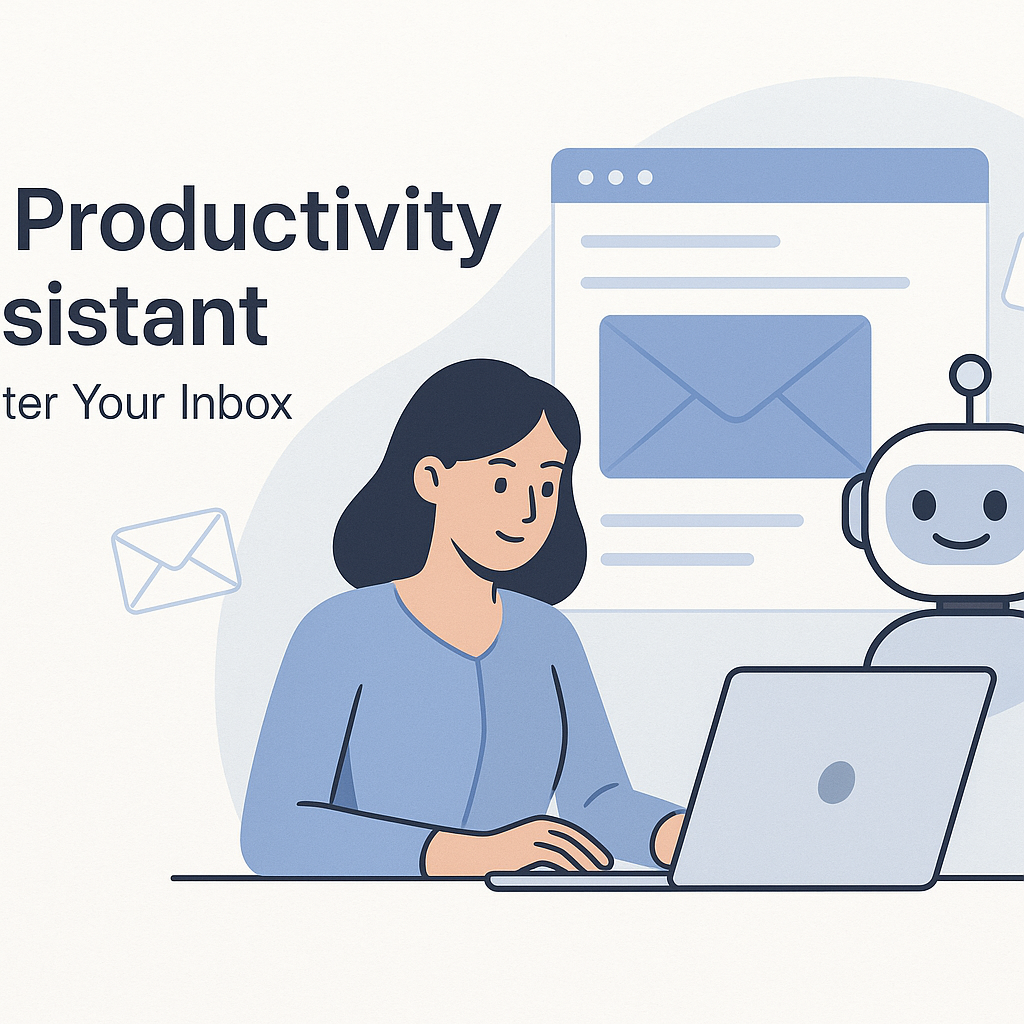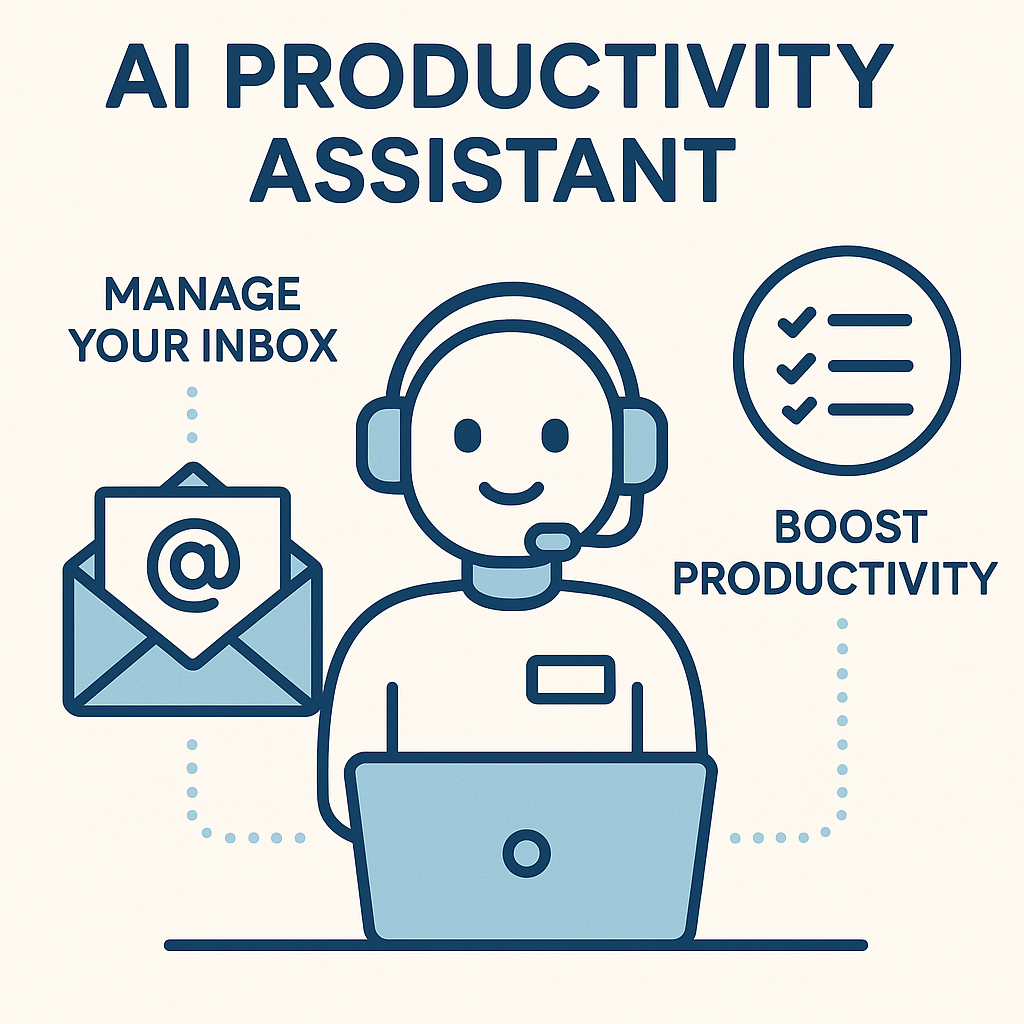AI Productivity Assistant: Master Your Inbox

In today's hyper-connected world, the inbox has become the central nervous system of professional life. For many, it's a relentless tide of messages, a constant demand on attention, and a significant drain on productivity. We juggle urgent requests, important updates, marketing newsletters, and client communications, often feeling like we're drowning in a sea of unread emails. The average professional spends hours each week managing their inbox, time that could be far better spent on strategic thinking, client engagement, or core business tasks. This overwhelming volume isn't just a time sink; it's a major contributor to stress, burnout, and missed opportunities. But what if there was a way to reclaim your time, bring order to the chaos, and transform your inbox from a source of dread into a powerful productivity hub? Enter the AI productivity assistant.
What is an AI Productivity Assistant for Email?
At its core, an AI productivity assistant is a sophisticated software tool designed to leverage artificial intelligence, particularly machine learning and natural language processing (NLP), to automate, streamline, and enhance your email management processes. Think of it as a highly efficient, always-on digital assistant dedicated specifically to your inbox. Unlike traditional email clients that merely organize and display messages, AI assistants actively work *with* your emails to reduce manual effort, improve decision-making, and boost overall communication efficiency.
These tools go beyond simple filtering or auto-replies. They are built to understand the context, urgency, and sentiment of your communications. Their capabilities can span:
- Intelligent Sorting and Prioritization: Automatically identifying and highlighting emails that require immediate attention.
- Automated Response Generation: Drafting replies to common queries or even complex messages based on context.
- Smart Scheduling: Finding optimal times for meetings and managing follow-up reminders.
- Summarization: Condensing long email threads or lengthy messages into digestible summaries.
- Sentiment Analysis: Helping you understand the tone and emotional subtext of messages.
- Task Management: Converting emails into actionable tasks and deadlines.
Essentially, an AI productivity assistant aims to minimize the cognitive load associated with email management, allowing you to focus on higher-value activities. As highlighted by Missive Blog, "AI email assistants are a powerful tool for streamlining communication and increasing productivity by helping you generate emails, create replies, translate, and fix your grammar and spelling mistakes." They act as a force multiplier, enabling individuals and teams to handle communication more effectively and efficiently.
How AI Assistants Prioritize and Sort Your Inbox
One of the most significant pain points of email overload is the sheer volume and the difficulty in discerning what needs immediate action versus what can wait. This is where AI email management truly shines. AI assistants employ advanced algorithms to analyze incoming emails, learning from your past interactions and preferences to create a truly smart inbox.
Here's how they achieve this:
- Natural Language Processing (NLP): AI uses NLP to read and understand the content of emails. It can identify keywords, detect urgency (e.g., "urgent," "ASAP," "deadline"), recognize sender importance (based on your contact list or past interactions), and even understand the intent behind the message.
- Machine Learning (ML): Over time, the AI learns your habits. If you consistently reply quickly to emails from your manager or a key client, the AI will flag similar emails as high priority. It can also learn to categorize emails based on project, topic, or sender, creating custom folders or labels automatically.
- Sender Reputation and History: Some AI tools can factor in the sender's historical communication patterns or even analyze sender reputation scores (like those found in Senderbase) to gauge the legitimacy and importance of an email.
- Actionable Item Detection: AI can identify emails that contain requests, questions, or action items, making it easier to track and respond.
The result is a dynamically prioritized inbox that presents you with the most critical communications first. This intelligent triage significantly reduces the time spent sifting through less important messages, helping you achieve more efficient email handling. For anyone struggling with how to organize inbox effectively, AI-powered sorting is a game-changer, ensuring that critical communications are never missed and that your attention is directed where it's most needed. This aligns perfectly with the goal of creating a more organized and responsive workflow.
Automating Responses and Drafting with AI
The repetitive nature of email communication is a prime target for AI automation. Crafting responses to frequently asked questions, sending follow-ups, or even composing initial outreach emails can consume a considerable amount of time. AI productivity assistants can drastically cut down on this manual effort.
AI-powered response generation works in several ways:
- Suggested Replies: Based on the content of an incoming email, AI can suggest pre-written or contextually relevant short responses (e.g., "Got it, thanks!", "I'll get back to you by end of day," "Can you provide more details?"). These can often be sent with a single click.
- Drafting Emails: More advanced AI can draft entire emails for you. You might provide a few bullet points or a brief prompt, and the AI will construct a polite, professional, and contextually appropriate email. This is invaluable for sales professionals needing to send personalized outreach or entrepreneurs managing client communications.
- Automated Follow-ups: AI can be programmed to send automatic follow-up emails if a response isn't received within a specified timeframe, ensuring that no lead or inquiry falls through the cracks. This is a cornerstone of email workflow automation.
- Grammar and Tone Correction: AI tools often include sophisticated grammar and style checkers, ensuring your outgoing emails are polished, professional, and convey the intended tone.
Imagine never having to type out "Thank you for your inquiry, we will respond within 24 hours" again. By automating these common tasks, AI frees up your mental energy and allows you to focus on crafting more strategic and impactful communications. This capability directly contributes to boosting productivity with emails ai, making communication faster and more consistent.
Leveraging AI for Smarter Email Scheduling and Follow-ups
Coordinating meetings and ensuring timely follow-ups are critical functions that often become bogged down in endless email chains. AI productivity assistants offer intelligent solutions to these scheduling headaches and help maintain momentum on important conversations.
AI-powered scheduling can:
- Find Optimal Meeting Times: By analyzing your calendar and potentially the recipient's availability (if integrated), AI can suggest the best times for meetings, minimizing back-and-forth negotiation.
- Automate Meeting Invites: Once a time is agreed upon, AI can automatically generate and send calendar invitations, including relevant details.
- Intelligent Follow-up Prompts: If you've sent an email that requires a response or action by a certain date, AI can remind you to follow up if the deadline is approaching or has passed without a reply. This is crucial for tasks like contract review, proposal submissions, or sales outreach.
For professionals juggling numerous projects and contacts, maintaining a rigorous follow-up schedule can be challenging. AI assistants can act as vigilant gatekeepers, ensuring that no critical deadline or potential opportunity is overlooked. Tools like an ai executive assistant can significantly streamline scheduling and follow-up processes, ensuring no critical communication falls through the cracks. This level of automation in email workflow automation is vital for maintaining client relationships and driving business forward.
AI for Understanding Email Sentiment and Tone
Communication is more than just words; it's about tone, sentiment, and underlying emotion. In professional settings, misinterpreting the tone of an email can lead to misunderstandings, damaged relationships, or missed opportunities. AI is increasingly being used to analyze the sentiment and tone of email communications, providing valuable insights for better AI for business communication.
Here's how AI sentiment analysis helps:
- Detecting Urgency and Emotion: AI can identify if an email carries a negative, positive, or neutral sentiment, and whether the sender is expressing frustration, urgency, or satisfaction. This is particularly useful for customer support teams or sales professionals dealing with client feedback.
- Managing Difficult Conversations: For managers or customer service representatives, understanding the emotional state of the sender can help tailor responses appropriately, de-escalate tense situations, and foster more constructive dialogue.
- Improving Personal Communication: By analyzing your own drafted emails, AI can alert you if your tone might be perceived as too blunt, aggressive, or passive, helping you refine your message for clearer and more effective communication.
- Gauging Customer Satisfaction: Businesses can use AI to scan incoming customer emails and feedback, quickly identifying satisfied customers for testimonials or unhappy customers requiring immediate attention.
While AI can't replicate human empathy, its ability to detect subtle cues in language can provide an objective layer of analysis, helping professionals navigate complex interpersonal dynamics more effectively. This enhances the overall quality of AI email management by adding a layer of emotional intelligence to digital interactions.
Security and Privacy Considerations with AI Email Tools
As AI tools become more integrated into our daily workflows, especially those handling sensitive business communications, security and privacy are paramount concerns. Granting an AI access to your inbox means entrusting it with potentially confidential information. It's crucial to select tools that prioritize data protection and adhere to stringent security standards.
When evaluating AI productivity assistants, consider the following:
- Data Encryption: Ensure that your emails and any data processed by the AI are encrypted both in transit and at rest. This protects your information from unauthorized access.
- Compliance: Look for tools that comply with relevant data privacy regulations such as GDPR, CCPA, or HIPAA, depending on your industry and location.
- Access Controls: Understand how the AI accesses your email account and what permissions it requires. Opt for tools that use secure authentication methods like OAuth.
- Data Usage Policies: Review the provider's privacy policy. How is your data used? Is it shared with third parties? Reputable providers will have clear policies that protect user data.
- Secure Mail Hosting: The underlying infrastructure also matters. Solutions offering robust secure mail hosting provide a foundational layer of protection for all communications, including those managed by AI.
Choosing AI solutions that champion robust security measures is not just good practice; it's essential for maintaining trust with clients and protecting your business's intellectual property. For instance, using tools that offer end-to-end encryption, like those focused on secure email for business, ensures that your AI-enhanced workflow doesn't compromise your data security.
Choosing the Right AI Productivity Assistant for Your Needs
The landscape of AI productivity tools is rapidly evolving, with numerous options available, each offering a slightly different set of features and focusing on specific user needs. Selecting the right one requires understanding your personal or team's primary pain points and objectives.
Here are key factors to consider:
- Identify Your Core Needs: Are you struggling most with sorting and prioritization, drafting responses, scheduling, or a combination of these? Some tools excel in specific areas, while others offer a broader suite of features.
- Integration Capabilities: Does the AI assistant integrate seamlessly with your existing email client (Gmail, Outlook, etc.) and other productivity tools (calendars, CRM, task managers)?
- User Interface and Experience: The tool should be intuitive and easy to use. A complex interface can negate the productivity gains. Many users find tools that mimic the speed and efficiency of platforms like Superhuman appealing, seeking similar streamlined experiences.
- Customization Options: Can you tailor the AI's behavior to your specific preferences? The ability to customize prioritization rules, response templates, and follow-up triggers is crucial.
- Cost and Scalability: Consider your budget and whether the tool offers plans that can scale with your business or team growth. Many offer free trials, which are excellent for testing functionality.
- Specific Role Requirements: An entrepreneur might need robust CRM integration and automated outreach drafting, while an executive might prioritize intelligent scheduling and summarization. Remote workers might benefit most from efficient handling of asynchronous communication.
As Shopify suggests, "When choosing an AI email assistant, consider how its features align with your productivity challenges and communication needs. Remember, the best email assistants balance automation and customization." Taking the time to research and test different email productivity tools will ensure you find a solution that genuinely enhances your workflow rather than adding another layer of complexity.
Conclusion: Reclaim Your Inbox, Reclaim Your Time
The modern inbox doesn't have to be a source of constant stress and lost productivity. By embracing the power of an AI productivity assistant, professionals across all industries can transform their email management from a chore into a strategic advantage. These intelligent tools offer sophisticated solutions for sorting, prioritizing, drafting, scheduling, and even understanding the nuances of communication.
From reducing the time spent on repetitive tasks with automated email responses to ensuring critical communications are never missed through intelligent follow-ups, AI is revolutionizing how we interact with our inboxes. It helps create a smart inbox experience, boosts AI for business communication, and enables truly efficient email handling. By investing in the right AI tools, you can significantly reduce cognitive load, minimize errors, and free up valuable hours to focus on what truly matters – growing your business, serving your clients, and achieving your professional goals.
Don't let email overload hold you back any longer. Start exploring the capabilities of AI assistants today and take the first step towards mastering your inbox and reclaiming your most valuable asset: your time.
```


